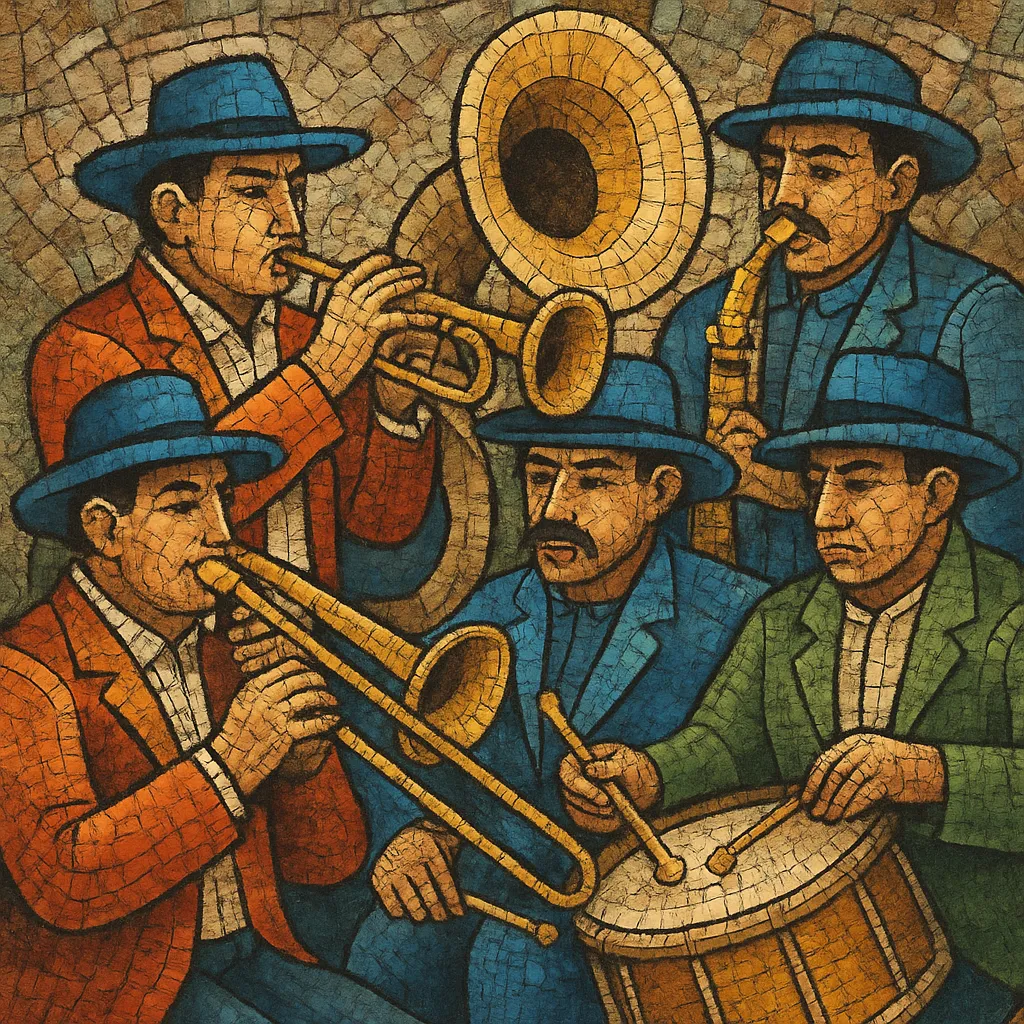Banda sinaloense is a brass-driven regional Mexican style that arose in the state of Sinaloa, blending European military band sonorities with local dance and song forms. Ensembles typically feature clarinets, trumpets, trombones, alto/baritone horns, and a tuba or sousaphone, anchored by the iconic tambora (bass drum with mounted cymbal) and tarola (snare drum).
Its repertoire spans lively polkas, waltzes, mazurkas, schottisches, and pasodobles, alongside Mexican corridos, rancheras, boleros, and modern cumbias. The sound is powerful and celebratory: unison brass fanfares, tight harmonized lines, and a driving “oom‑pah” low end support emotive lead vocals and energetic percussion, making it a staple of festivals, dances, and contemporary charts.
Banda sinaloense emerged in Sinaloa during the late 1800s as local musicians adapted European-style military and civic brass bands to regional tastes. Immigrant and itinerant influences brought polkas, waltzes, mazurkas, schottisches, and pasodobles, which were reinterpreted with Mexican rhythmic feels and the distinctive tambora–tarola percussion pairing.
By the 1930s, professional groups such as Banda El Recodo (founded 1938 by Cruz Lizárraga) helped codify instrumentation (clarinets, trumpets, trombones, alto/baritone horns, tuba) and a repertoire mixing European dances with corridos, rancheras, and boleros. Radio and early records spread the style across northwestern Mexico.
From the 1970s onward, banda ensembles proliferated, refining arrangements and vocal-forward formats. The 1990s saw a "romántica" wave of love ballads arranged for banda and the rise of technobanda, which blended banda brass idioms with electric keyboards, bass guitar, and pop production, bringing the sound to broader audiences.
In the 2000s and 2010s, Sinaloan bands topped charts in Mexico and among Mexican and Latinx communities in the United States. Acts like Banda MS and Banda Los Recoditos expanded the genre’s pop presence, while banda arrangements became a standard vehicle for corridos old and new. Streaming-era "regional mexicano" playlists cemented banda sinaloense as a flagship sound with sustained commercial and cultural influence.
Write for a standard banda: 2–3 clarinets, 2–3 trumpets, 2–3 trombones, alto/baritone horns (charchetas), tuba/sousaphone, tambora (bass drum with cymbal), and tarola (snare). The tuba provides an "oom‑pah" or walking bass; clarinets and trumpets carry melodies and countermelodies; trombones and horns supply inner harmonies and rhythmic stabs.
Use dance meters: polka (2/4, bright tempo), waltz/mazurka (3/4), schottische/pasodoble (4/4 or 2/4 with dotted figures), and cumbia (4/4 with a lilt). The tarola articulates backbeats, rolls, and fills; the tambora marks downbeats and crashes. Keep grooves simple, driving, and danceable.
Favor diatonic major/minor keys with functional harmony (I–IV–V, ii–V–I, secondary dominants). Melodies are lyrical and singable, often doubling in unison or thirds/sixths. Use antiphony between vocals and clarinets/trumpets. Modulations up a whole step for final choruses are common for lift.
Typical forms mirror pop and ranchera: intro–verse–chorus–verse–chorus–bridge/solo–chorus–coda. Start with a brass fanfare or clarinet riff; feature brief instrumental interludes and call‑and‑response shout sections. Keep dynamic contrasts clear, reserving full brass tuttis for hooks.
Write narratives (corridos) or romantic/celebratory texts (bailes, brindis). Themes include love, heartbreak, pride, hometown life, and storytelling. Keep phrasing direct and emotive, leaving space for instrumental responses.
Compose in concert pitch, then transpose for Bb/Eb instruments; choose brass-friendly keys (F, Bb, Eb, C, G). Balance registers so clarinets aren’t masked by trombones; leave low‑mid space for the tuba. Record percussion with crisp tarola articulation and impactful tambora hits; avoid overcompression to preserve ensemble punch.


